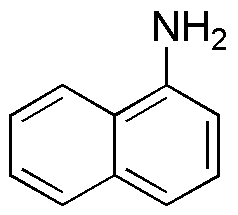a-Naphthylamine is widely utilized in research focused on:
- Dyes and Pigments: It serves as a precursor in the production of azo dyes, which are widely used in textiles and food coloring, offering vibrant colors and excellent stability.
- Rubber Industry: This compound is employed as an antioxidant in rubber manufacturing, enhancing the durability and lifespan of rubber products, which is crucial for tires and industrial applications.
- Pharmaceuticals: a-Naphthylamine is involved in synthesizing various pharmaceutical compounds, contributing to the development of medications with improved efficacy and reduced side effects.
- Analytical Chemistry: It is used as a reagent in various analytical techniques, such as spectrophotometry, to detect and quantify specific substances, aiding researchers in chemical analysis.
- Research in Toxicology: The compound is studied for its potential carcinogenic properties, helping researchers understand the health risks associated with exposure and informing safety regulations.
General Information
Properties
Safety and Regulations
Applications
a-Naphthylamine is widely utilized in research focused on:
- Dyes and Pigments: It serves as a precursor in the production of azo dyes, which are widely used in textiles and food coloring, offering vibrant colors and excellent stability.
- Rubber Industry: This compound is employed as an antioxidant in rubber manufacturing, enhancing the durability and lifespan of rubber products, which is crucial for tires and industrial applications.
- Pharmaceuticals: a-Naphthylamine is involved in synthesizing various pharmaceutical compounds, contributing to the development of medications with improved efficacy and reduced side effects.
- Analytical Chemistry: It is used as a reagent in various analytical techniques, such as spectrophotometry, to detect and quantify specific substances, aiding researchers in chemical analysis.
- Research in Toxicology: The compound is studied for its potential carcinogenic properties, helping researchers understand the health risks associated with exposure and informing safety regulations.
Documents
Safety Data Sheets (SDS)
The SDS provides comprehensive safety information on handling, storage, and disposal of the product.
Product Specification (PS)
The PS provides a comprehensive breakdown of the product’s properties, including chemical composition, physical state, purity, and storage requirements. It also details acceptable quality ranges and the product's intended applications.
Certificates of Analysis (COA)
Search for Certificates of Analysis (COA) by entering the products Lot Number. Lot and Batch Numbers can be found on a product’s label following the words ‘Lot’ or ‘Batch’.
*Catalog Number
*Lot Number
Certificates Of Origin (COO)
This COO confirms the country where the product was manufactured, and also details the materials and components used in it and whether it is derived from natural, synthetic, or other specific sources. This certificate may be required for customs, trade, and regulatory compliance.
*Catalog Number
*Lot Number
Safety Data Sheets (SDS)
The SDS provides comprehensive safety information on handling, storage, and disposal of the product.
DownloadProduct Specification (PS)
The PS provides a comprehensive breakdown of the product’s properties, including chemical composition, physical state, purity, and storage requirements. It also details acceptable quality ranges and the product's intended applications.
DownloadCertificates of Analysis (COA)
Search for Certificates of Analysis (COA) by entering the products Lot Number. Lot and Batch Numbers can be found on a product’s label following the words ‘Lot’ or ‘Batch’.
*Catalog Number
*Lot Number
Certificates Of Origin (COO)
This COO confirms the country where the product was manufactured, and also details the materials and components used in it and whether it is derived from natural, synthetic, or other specific sources. This certificate may be required for customs, trade, and regulatory compliance.


